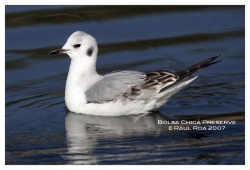| This article is incomplete. This article is missing one or more sections. You can help the BirdForum Opus by expanding it. |
- Larus philadelphia
Identification
Generally easily identified among small hooded gulls by light gray back, pink legs, small black bill, and less extensive black on primaries in flight.
Similar species
Little Gull is smaller with thinner shorter bill, slightly more extensive hood, red legs (1st winter pink), and very short primary projection.
Black-headed Gull is slightly larger with perhaps slightly lighter back, less extensive brownish hood, slightly larger red bill (in all plumages except juvenile which has pale bill), extensive black on primaries in flight, and reddish legs (1st winter has orange).
Franklin's Gull is larger with much darker back and larger bill.
Laughing Gull is much larger with much darker back and much larger bill.
Distribution
Breeds in Alaska and east across Canada to James Bay with non-breeders present in summer on north-eastern coasts.
Winters from the Great Lakes southwards and on the Atlantic coast from New England south to the Caribbean. Leaves breeding grounds in late July with many gathering off Nova Scotia in late August-early September, return movement in April-May.
Vagrancy
Fairly frequent vagrant to the Western Palearctic most often recorded in the British Isles but also in Iceland and Scandinavia, the Netherlands, Belgium and France, Germany, Hungary, Iberia, Morocco and the Azores. British records (c.115) mainly in the south-west but also east to Norfolk and north to Shetland. The records are spread throughout the year and include long-staying and returning individuals and both adults and immatures.
Taxonomy
This is a monotypic species. Some authorities place this species in genus Chroicocephalus.
Habitat
Breeds beside pools and swamps in tundra and taiga. Out of the breeding season found at freshwater and saline lakes, following the plough on farmland and by the sea. In coastal areas seen on sandy shores and mudflats, estuaries, harbours and on coastal lakes and lagoons.







